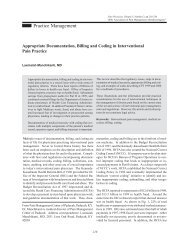ASIPP Practice Guidelines - Pain Physician
ASIPP Practice Guidelines - Pain Physician
ASIPP Practice Guidelines - Pain Physician
You also want an ePaper? Increase the reach of your titles
YUMPU automatically turns print PDFs into web optimized ePapers that Google loves.
Manchikanti et al • <strong>ASIPP</strong> <strong>Practice</strong> <strong>Guidelines</strong><br />
71<br />
joint injections should be repeated only as necessary<br />
judging by the medical necessity criteria and<br />
these should be limited to a maximum of six times<br />
for local anesthetic and steroid blocks for a period<br />
of one year.<br />
Trigger Point Injections:<br />
• In the diagnostic or stabilization phase, a patient<br />
may receive trigger point injections at intervals<br />
of no sooner than one week and preferably two<br />
weeks.<br />
• In the treatment or therapeutic phase (after the<br />
stabilization is completed), the frequency should<br />
be two months or longer between each injection<br />
provided that at least >50% relief is obtained for<br />
six weeks.<br />
• In the diagnostic or stabilization phase, the number<br />
of trigger injections should be limited to no<br />
more than four times per year.<br />
• In the treatment or therapeutic phase, the trigger<br />
point injections should be repeated only as necessary<br />
judging by the medical necessity criteria<br />
and these should be limited to a maximum of six<br />
times for local anesthetic and steroid injections.<br />
• Under unusual circumstances with a recurrent<br />
injury or cervicogenic headache trigger point injections<br />
may be repeated at intervals of six weeks<br />
after stabilization in the treatment phase.<br />
Combination of Blocks/Interventions: It may be essential<br />
to combine, in certain circumstances, more than one<br />
block. This may include an epidural for the cervical region<br />
and facet-joint blocks for the lumbar region; epidural<br />
and facet-joint blocks for the same region in case of identification<br />
of pain generators from both sources; a sympathetic<br />
block and facet-joint block if there are two different<br />
sources of pain or if two different regions are affected in<br />
combination with trigger-point injections. Consequently,<br />
blocks also may be combined with other interventional techniques.<br />
OUTCOMES AND COST-EFFECTIVENESS<br />
Outcomes may be assessed by evaluation of the quality of<br />
life, which is also known as functional status, health status,<br />
health-related quality of life; well-being of the patient,<br />
satisfaction with care, health services utilization/economic<br />
analysis, and medical findings (793-802). The quality-oflife<br />
assessment is designed to evaluate the patient’s abilities<br />
to function in his/her own world. Physical functioning<br />
measures the ability to perform physical activities such as<br />
walking, climbing stairs, or carrying things. Evaluation<br />
focuses on the patient’s major perceived functional impairments,<br />
improvement in areas such as playing with children/grandchildren,<br />
having sexual relations, returning to<br />
work, going to school, homemaking or performing other<br />
activities of daily living. Quality of life also measures social<br />
functioning, which determines whether health problems<br />
affect normal social activities, such as seeing friends<br />
or participating in group activities.<br />
Similarly, confusion abounds over what is meant by the<br />
term cost-effectiveness. Cost-effectiveness analysis has<br />
taken on an increasingly large role in health care policy<br />
debates about interventions for various types of interventions<br />
in managing low back pain. Growing health care<br />
costs and productivity losses, disappointing treatment results,<br />
and changing beliefs about health and pain have led<br />
to this increasing concern about the amount of money spent<br />
on chronic pain in general and low back pain in particular.<br />
In recent years, more and more studies in the field of the<br />
management of chronic low back pain have been incorporating<br />
cost issues in their analysis (795, 803-809). While<br />
economic evaluation designs describe cost minimizationanalysis<br />
(CMA), cost-benefit analysis (CBA), cost-effectiveness<br />
analysis (CEA), or cost-utility analysis (CUA), in<br />
chronic low back pain, CEA and CUA would be the most<br />
appropriate methods to use, since in these studies the effects<br />
are measured in natural units and quality of life. The<br />
outcome measures used in CEA studies in chronic pain<br />
research mainly include outcomes, such as disability days<br />
saved, pain-free days, or improved quality of life, etc. (803).<br />
Cost of inpatient chronic pain programs range from $17,000<br />
to $25,000 and the cost of outpatient treatment programs<br />
range from $7,000 to $10,000 (802). In addition, chronic<br />
pain patients may incur health care bills in excess of<br />
$20,000 annually for repetitive and, in some cases, redundant<br />
diagnostic work ups, physical therapy, psychological<br />
interventions, and drugs. Guo and colleagues (810) estimated<br />
that back pain accounted for 150 million lost work<br />
days in the United States every year, which worked out to<br />
be about $14 billion in wage costs alone. The study showed<br />
that the magnitude of the back pain problem is so large<br />
that even a 1% reduction in overall prevalence could considerably<br />
reduce morbidity and save billions of dollars.<br />
The cost-effectiveness of lumbar discectomy for the treatment<br />
of herniated intervertebral discs has been based on<br />
the conclusion that surgery increased the average qualityadjusted<br />
life expectancy by 0.43 years during the decade<br />
following treatment compared to conservative treatment,<br />
a result comparable to extending a healthy life by five<br />
<strong>Pain</strong> <strong>Physician</strong> Vol. 4, No. 1, 2001
















